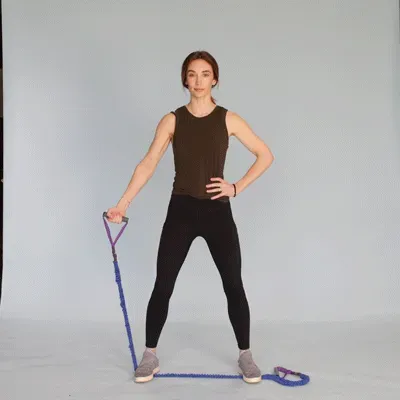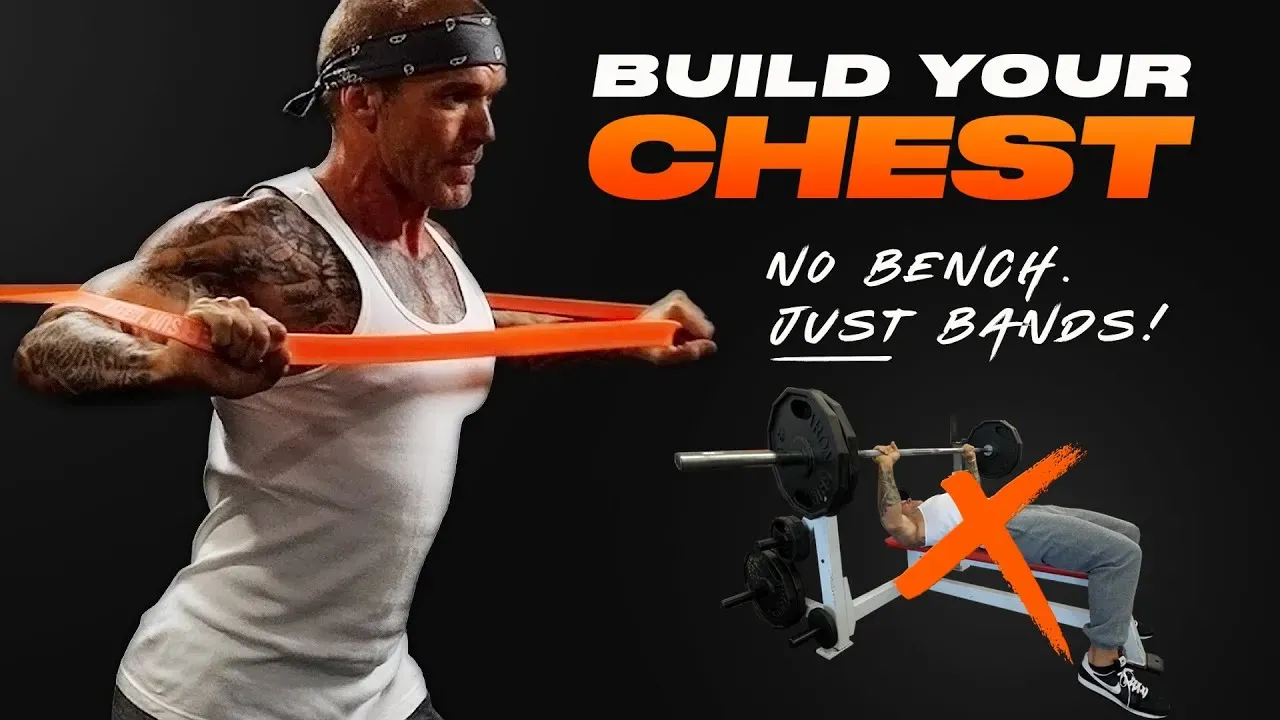Table of Contents
Let's be honest, hitting the gym isn't always in the cards. Maybe the commute's a nightmare, maybe childcare fell through, or maybe you just can't stand the guy who grunts loud enough to shake the free weights. Whatever the reason, abandoning your chest gains isn't the answer. If you're looking for a solid alternative to traditional weights without leaving your living room, a band chest workout at home might just be your ticket.
Why a Band Chest Workout at Home Works

Why a Band Chest Workout at Home Works
Constant Tension, Real Gains
Look, when you're lifting dumbbells or using machines, there are often points in the movement where the tension on your muscles drops off. Think about the top of a bench press – gravity isn't pulling straight down on your chest anymore. Bands are different. They provide resistance through the entire range of motion. As you stretch the band further, the tension increases, forcing your chest muscles to work harder from the stretched position right through to the squeeze at the top. This constant, escalating resistance is a serious driver for muscle growth, making a band chest workout at home surprisingly effective.
Joint-Friendly and Versatile Resistance
Let's face it, traditional weightlifting can be tough on the joints over time. The fixed path of a machine or the sheer weight of a heavy barbell can put stress on shoulders and elbows. Resistance bands offer a much more joint-friendly alternative. The resistance is smooth and accommodating, adapting to your natural movement patterns. Plus, they allow for a huge variety of angles and movements that are sometimes awkward or impossible with free weights. Want to hit that inner chest squeeze? Bands make it simple. Looking for decline press without an expensive bench? Bands have you covered. This adaptability is key to a comprehensive band chest workout at home.
- Bands provide escalating tension throughout the entire range of motion.
- They are significantly easier on your joints compared to free weights.
- Bands allow for a wider variety of exercise angles and movements.
- They are portable and take up virtually no space.
Essential Bands for Your At Home Chest Workout

Essential Bands for Your At Home Chest Workout
Alright, so you're sold on the idea of building your chest without leaving your living room. Great. But you can't just grab any old rubber band from the office supply closet and expect results. For a proper band chest workout at home, you need the right tools. We're talking about quality resistance bands that can handle serious tension and won't snap mid-rep (trust me, that's a bad day). You'll primarily want loop bands, also known as powerlifting bands or pull-up assist bands. These come in various resistance levels, usually color-coded, from light assistance to heavy-duty tension. Having a few different resistances is key because some exercises require less tension for proper form, while others let you load up. A door anchor is also a game-changer; it lets you perform movements like flyes and presses from angles that mimic cable machines.
Top Exercises for Your Band Chest Workout at Home

Top Exercises for Your Band Chest Workout at Home
Band Presses: Your Foundation Builder
Think of band presses as your bench press equivalent when doing a band chest workout at home. You can anchor the band behind you on a sturdy pole, a door anchor, or even have a partner hold it (though finding a reliable partner is often harder than just getting a door anchor). Position yourself like you're setting up for a push-up, but instead of your hands on the floor, you're gripping the band handles or loops. Keep your core tight, shoulders back and down. Press your hands straight out in front of your chest, squeezing your pecs hard at the top. Control the band as it tries to pull your hands back. This movement hits the bulk of your chest muscle fibers, just like a traditional press. You can adjust your stance or band tension to make it harder or easier. I remember trying this for the first time thinking it'd be easy; five reps later, my chest was screaming. The constant tension is no joke.
Band Flyes: Sculpting That Inner Pec Line
Cable flyes are a gym staple for isolating the chest and getting that satisfying squeeze in the middle. With bands and a door anchor, you can replicate that feeling perfectly during your band chest workout at home. Set the door anchor at chest height. Grab a band in each hand, standing facing away from the door. Step forward to create tension. With a slight bend in your elbows, bring your hands together in front of your chest, imagining you're hugging a barrel. Focus on contracting your inner chest muscles. Control the eccentric (the way back) as the bands pull your arms outwards. This exercise is money for hitting those inner fibers that bench presses sometimes miss. Try different anchor heights – higher for a decline feel, lower for an incline feel.
Exercise | Target Area | Setup Notes |
|---|---|---|
Band Press | Overall Chest Mass | Anchor band behind back/door. Press straight out. |
Band Flye | Inner Chest Separation | Door anchor at chest height. Bring hands together. |
Incline Band Press | Upper Chest | Anchor band low (near floor). Press upwards. |
Decline Band Press | Lower Chest | Anchor band high (overhead). Press downwards. |
Incline and Decline Variations: Hitting Every Angle
A complete band chest workout at home requires hitting the muscle from multiple angles, just like you would in a gym. Luckily, bands make this simple. For incline presses, you need to anchor the band low, near the floor (using a door anchor or stepping on the band if it's long enough). Lie on your back (or stand and lean slightly back) and press the bands upwards and slightly inwards, mimicking an incline dumbbell press. This targets the upper chest, which often lags for many people. Conversely, for decline presses, anchor the band high, above your head. Stand or kneel facing away from the anchor and press the bands downwards and slightly inwards. This hits the lower chest. Don't skip these variations; they ensure balanced development.
Structuring Your Band Chest Workout at Home Routine

Structuring Your Band Chest Workout at Home Routine
How Often and How Much?
Alright, you've got the bands, you know the moves – now how do you actually put it all together into a routine that builds a respectable chest? Consistency is king here, just like with any training. Aim for two to three band chest workout at home sessions per week, allowing at least 48 hours between them for recovery. Don't smash your chest seven days a week; that's a one-way ticket to Overtrain City, and nobody wants a ticket there. For most exercises, aim for 3-4 sets. Rep ranges can vary depending on your goal, but for muscle growth (hypertrophy), shooting for 8-15 reps per set is a solid bet. If you can easily crank out more than 15 reps with good form, it's time for a thicker band or a different exercise variation that offers more resistance.
Putting the Pieces Together
Building your band chest workout at home isn't rocket science, but it does require some thought. You want to hit the muscle from different angles. A good starting point is to pick one or two pressing movements (like the band press or incline band press) and one or two flye movements. Varying the anchor height for presses is a simple way to target upper, middle, and lower chest fibers. Don't just do flat presses every time. Maybe one workout focuses on incline and flat, and the next hits decline and flyes. Keep a little logbook or use a notes app on your phone. Track the bands you used and the reps you got. This makes it easy to see progress and know when to bump up the resistance. Stalling out on reps with a certain band? Try adding an extra set or slowing down the negative part of the rep.
Sample At Home Band Chest Workout
- Band Presses (Flat or Incline): 3 sets, 10-15 reps
- Band Flyes (Chest height anchor): 3 sets, 12-15 reps
- Decline Band Presses: 3 sets, 10-15 reps
- Band Push-Ups (with band across back): 3 sets, as many reps as possible
Common Mistakes to Avoid in Your Band Chest Workout

Common Mistakes to Avoid in Your Band Chest Workout
Ignoring Proper Form
Alright, so you've got the bands, you're feeling the tension, but are you actually hitting your chest? A big mistake people make with a band chest workout at home is letting their form go sloppy. It's easy to start using your shoulders, triceps, or even your back to muscle the bands through the movement, especially as fatigue sets in or if the band is too heavy. You see folks flailing their arms, shoulders shrugged up by their ears, looking less like a chest press and more like they're trying to swat a particularly aggressive fly. Remember, the goal is to contract the chest muscles. Keep your shoulders down and back, maintain that slight bend in the elbow during flyes, and control the movement both on the way out and on the way back. Don't just snap the band; resist it. Quality reps trump quantity every single time when you're doing a band chest workout at home.
Not Using Enough Tension (Or Too Much)
Another common pitfall when doing a band chest workout at home is getting the resistance wrong. Some people grab the lightest band they have and do fifty reps that feel like stretching a rubber band around a newspaper. You're not going to build much muscle doing that. On the flip side, some try to wrestle with a band that's way too thick, sacrificing form completely just to move it an inch. You need a band that challenges you within the target rep range (8-15 reps for hypertrophy). If you can do 20+ reps easily, grab a thicker band or double up. If you can barely get five with terrible form, lighten up. Finding that sweet spot where the last few reps are a real struggle, while maintaining good form, is crucial for making progress.
Band Workout Pitfalls to Sidestep
- Rushing through reps instead of controlling the movement.
- Letting shoulders take over the exercise.
- Using bands that are too light for a challenge.
- Using bands that are too heavy and compromising form.
- Ignoring the eccentric (negative) part of the rep.
- Not tracking progress (bands used, reps completed).
Final Thoughts on Your At Home Band Chest Workout
So there you have it. Building a powerful chest doesn't require a gym membership or a garage full of iron. A well-structured band chest workout at home offers a legitimate path to strength and size, provided you approach it with the right tools and technique. Bands offer constant tension, are easy on your joints, and can travel with you anywhere. Consistency remains key, as with any training program. Stick to the fundamentals, focus on controlled movements, and progressively challenge yourself. It might not look like hoisting massive barbells, but the work gets done, and the results will speak for themselves.
